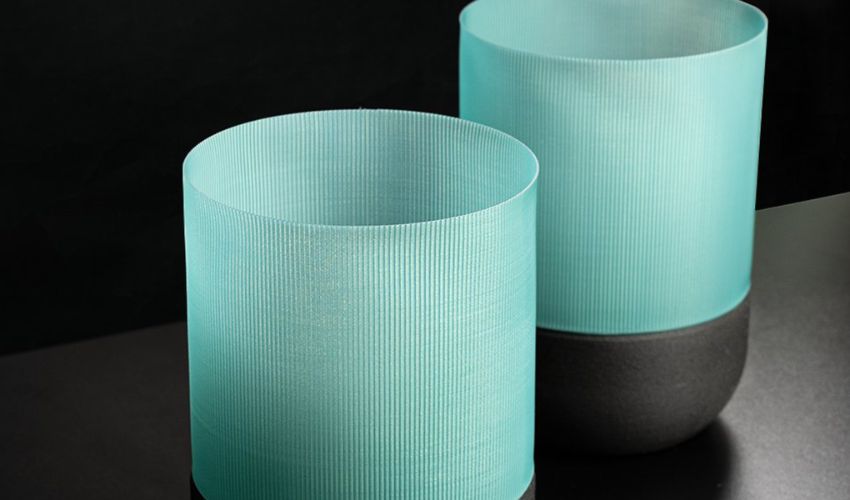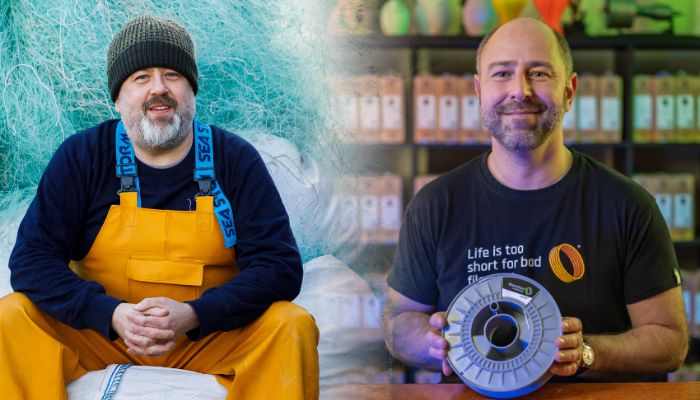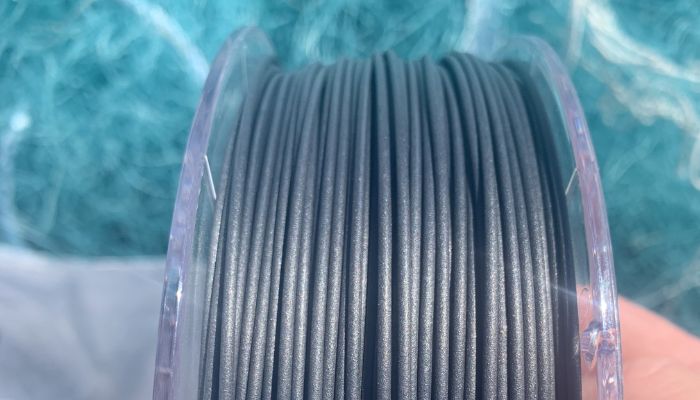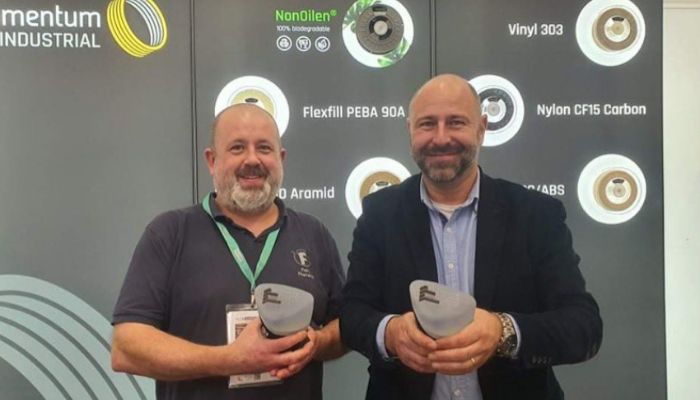Fishy Filaments and Fillamentum on Making Sustainable 3D Printing Materials Out of Fishing Nets

With the world continuously warming and experts expressing fear that we may not meet the goals outlined in the Paris Agreements, sustainability is the topic of the hour in almost every industry. Additive manufacturing is certainly no exception. Though 3D printing often is touted as more environmentally friendly, the amount of plastic that is used has often put that into question. For this reason, we are increasingly seeing a drive to develop more eco-friendly materials. This is the case with Cornish startup Fishy Filaments. They are attacking two environmental concerns at once by recycling polluting fishing nets into nylon filaments, working as well with leading material manufacturer Fillamentum which is also known for its sustainable efforts. We spoke with Ian Falconer, the founder of Fishy Filaments, and Josef Doleček, the CEO and founder of Fillamentum, to learn more about the companies, the importance of sustainable 3D printing materials and their collaboration.
3DN: Could you introduce yourself and your connection to 3D printing?
IF: My name is Ian Falconer. I’m the founder of Fishy Filaments. My academic background is in mining and mineral processing, so materials rather than 3D printing as a manufacturing technology. But I also have around a decade of experience as an engineer in global telecoms infrastructure. Fishy Filaments is synthesis of those two worlds; taking ideas and technologies from both and delivering a new look at providing high performance materials without a global supply chain.

Ian Falconer (left) and Josef Doleček (right)
JD: My name is Josef Doleček, since 2008 I have been working in the field of plastics processing, first as an employee in a plastics company. In 2011, I founded a company for precision extrusion of plastics for the automotive industry. When I first became acquainted with 3D printing, I immediately felt that I could bring my experience in processing polymer materials to this field. And this is a goal I’ve been trying to fulfill since the very beginning of our 3D printing materials business through our 3D printing filament brand Fillamentum.
3DN: How did the idea to develop Fishy Filaments come about?
IF: I was working in the mine finance sector for a company who wanted to develop a very large metals mine and they asked me to take a multi-decadal look at their markets. They were mining titanium, vanadium and had a by-product of high purity iron ore – all as powders. I saw some road blocks in that world if they were to serve Additive Manufacturing at a sustainable price and decided to try and address them.
For various reasons I didn’t get to the point of delivery with those solutions within the metals world but found that they worked just as well, and probably better, in the world of polymer recycling. Fishy Filaments embodies a technological solution that was looking for a problem and found it in end-of-life fishing gear.
3DN: What is the importance of recycling fishing nets into filaments?
IF: While the solution was quite definitely engineering and science led, the problem of fishing gear management and disposal is very nuanced and complex, but globally important. The particular type of nets we target, made from nylon monofilaments, are responsible for around 20% of the global fishing catch by tonnage and by value. They are used by all kinds of fishers from individual artisanal and sport fishers working alone with a throw net from the shores of The Ganges or to catch bait for larger species, all the way up to giant boats working on the high seas with nets several kilometers long. It may be a surprise that the materials all the way along that wide spread of scale are essentially the same – they are all nylon monofilament.
The plastics industry knows that it sells somewhere around 200,000 tonnes a year of nylon monofilament into the fishing industry. At Fishy Filaments we think it may be quite a bit more than that, and maybe all the way up to 400,000 tonnes a year as there is some crossover with agricultural nets, mosquito nets and other uses for nylon ‘mono’ as Cornish fishers call it.
Very little of that material gets recycled. Most gets burned or buried after use and, according to data from researchers at Australia’s CSIRO, around 1-2% of monofilament nets get lost at sea. In water the science suggests a nylon monofilament netting takes over 6 centuries to degrade. So once lost it’s effectively there for good and represents a permanent hazard to non-target species in the phenomenon called ‘ghost netting’. But from this engineer’s point of view; disposing of this material, an engineering grade plastic that is designed for a really tough application, is a tragic waste of a resource.

Close-up of 0rCA spool in fishing net (photo credits: Fillamentum)
JD: Which is something that also really concerns us at Fillamentum. I have to say that when I heard about the circular economy many years ago, I had a very vague perception of the concept, and I couldn’t really imagine concrete applications – if only because until relatively recently there were very few meaningful circular projects. As a plastics professional, I was frustrated that our industry was perceived negatively, and I took it as my big task to show users and the general public that there are alternative ways that are environmentally friendly. As we had included a material of this nature ourselves, Nonoilen, and the response was positive, it seemed a logical step to include Fishy Filament in our portfolio. This is precisely because it is a beautiful example of how the problem of reusing plastic waste can be sensibly approached.
3DN: Could you tell us more about Fishy Filaments by Fillamentum?
IF: Our target consumers are advanced and industrial users who need performance and sustainability. We have Life Cycle Assessments for each product and will be undertaking corporate grade sustainability certification in the coming years. All our products have world leading carbon impact credentials that we make available to support marketing and financial reporting of ESG.
We have two product groups; unfilled and filled. All our current products are 100% recycled, but we do have some advanced formulations in R&D that use graphene and other addmixes. Our unfilled blends are Porthcurno and Longships. Both are translucent when thin and have been used to produce homewares, cosmetic packaging, jewelry and fashion items.
Porthcurno is an especially attractive light blue-green and has taken the world of lighting by storm. With Signify/Philips Lighting we won (a share of) an IDSA (Industrial Design Society of America) IDEA Gold prize with their Coastal Breeze collection of 3D printed lumieres. That puts us on a par with Microsoft, Google and Rolls Royce.
Longships has yet to be made available as a filament due to some technical hurdles there, but we may look at that in the future as they are addressed. It has a different, darker color profile and is slightly stiffer. Our main use for Longships is as a compounding base for our 0rCA® family of carbon-filled filaments. The first of the 0rCA® family has 10% carbon fiber fill, and it’s a recycled carbon fiber meaning filament made from it meets the 100% recycled criteria. The carbon fiber we use is a custom blend of cut and milled fibers designed to meet the challenges of 3D printing but also maximize the flexibility of application.
We’re aiming to serve manufacturers that have the need for high strength, impact resistance and a mid-range of heat resistance (so hot engine compartment – fine, but hot engine component – probably not). We’ve had interest from sustainable and inclusive mobility (EVs, cycling, mobility aids, etc), sports (extreme, water, racquet and motor so far), industrial component manufacturing and more. In time we will be adding to the 0rCA® family with a higher stiffness version targeted at applications in high G and higher torque environments such as wind turbine blade tips, unmanned aerial vehicles & robotics.
We are also working with other manufacturing methods, both conventional and HiTech, to develop the concept of mono-materiality as a means to ease the recycling potential of complex structures. The idea here is to build from the same core chemistry and for that chemistry to be recyclable in the same stream. We’ll be talking more about that idea as an overarching concept for closing the materials loop in advanced manufacturing, but it’s already part of the conversation in both fashion and auto markets.

Josef Doleček and Ian Falconer with the 3DPI 2021 Awards for Sustainability in AM (Fishy FIlaments) and Materials Company of the Year (Fillamentum) (photo credits: Fillamentum)
JD: To add on, here we have a unique product that meets strict criteria in terms of performance – Fishy Filaments is a high quality PA6 polyamide which allows it to be used in technical, let’s say industrial applications such as automotive, but because of its unique look and story it is primarily designers and those who will use a combination of these properties for 3D printed design consumer items.
3DN: Any last words for our readers?
IF: We’re a small company working at the very edge of Europe that has already changed the world when, in 2019, we launched the first ever commercial 3D printer filament made from used fishing gear. That action has forced a change by other, far bigger, companies and opened a brand new market. Four years on and that market is maturing rapidly, but we haven’t stopped there.
Our products are at the cutting edge of sustainability, where engineering technology needs to be weighed against its own environmental impact and materials can make a big difference to performance. We allow product designers and manufacturers to find their own, unambiguous, guilt-free voice when utilizing our products and believe that proliferation of solutions is essential if we are to meet the global environmental challenges we all face. We’ve found a brilliant partner in Fillamentum to help upscale our ideas, adding their own expertise and together bring exciting new products to market.
We will continue to be guided by the data, with carbon impact being our own moral compass, so it’s fantastic to be working with Josef & co who we know share our belief in and commitment to a positive future.
JD: We at Fillamentum take sustainability and respect for our environment not only as a modern trend, but above all we want to show that this trend is not just empty words, but that it makes sense for the betterment of all. We would be happy if our view of the world, which we expressed years ago in a simple slogan – think before you print, would be adopted by both ordinary and especially professional users of 3D printing. We want to show that the sustainable way – using recycled materials does not mean compromising on performance. And we also want to show that it is new technologies that face environmental challenges head-on and can offer solutions.
I am very pleased to have found in Fishy Filaments and in Ian Falconer someone with whom I share not only a similar perspective on sustainability issues in 3D printing, but also the same professional honor that motivates us to pursue solutions that match the level of scientific knowledge and social maturity that reflects the 21st century. You can learn more about Fishy Filaments HERE and Fillamentum HERE.
What do you think of this collaboration between Fishy Filaments and Fillamentum? Let us know in a comment below or on our LinkedIn, Facebook, and Twitter pages! Don’t forget to sign up for our free weekly Newsletter here, the latest 3D printing news straight to your inbox! You can also find all our videos on our YouTube channel.
*Cover Photo Credits: Fillamentum






